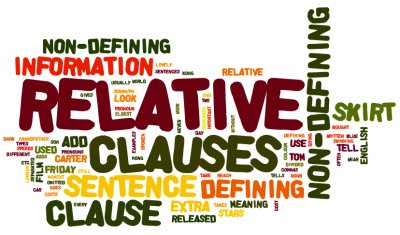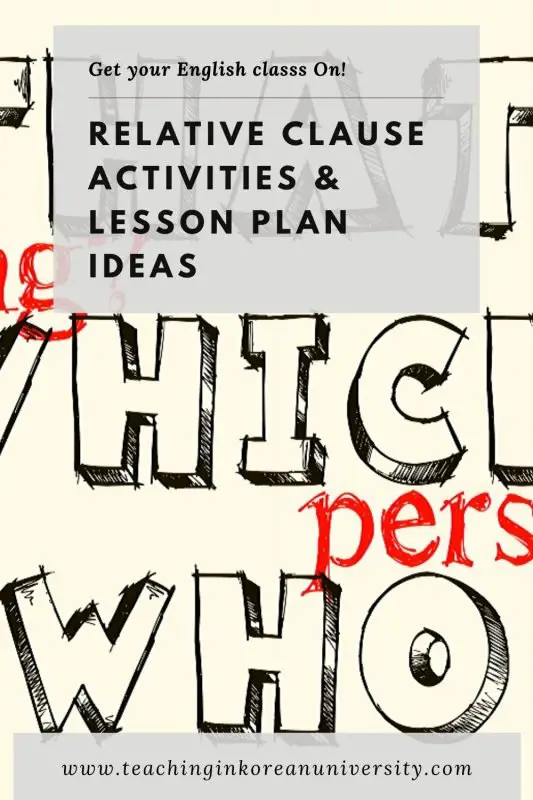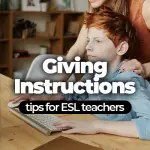You can usually find relative clauses in almost all high-beginner to advanced level textbooks. So, if you’re looking for some help with teaching relative clauses including the best activities and games, worksheets and lesson plans then you’re certainly in the right place. Keep on reading for all the games and activities you’ll need when teaching relative pronouns and clauses.

Relative Clauses Activities and Games
Let’s get into the best relative clause activities that you might want to try out with your students.
Relative Clause Games and Activities: Top 10 Picks
Of course, it’s more fun for the students to try out some games and activities to help them practice relative clauses instead of just powering through more worksheets or the textbook. Here are some of my top recommendations for ESL activities you can to teach relative clauses.
#1: Board Games for Relative Clauses
If you’re looking for a fun, engaging, 4-skills ESL activity then you’ll want to try out some board games with your students. Once you get a little bit of practice with it, you’ll find that it’s super easy to make your own in just a few minutes.
In this case, you’d want to fill the board with questions that will lead to answers with relative clauses. Want to know more? Find out all the details you need to know here:
#2: Relative Clause Speaking Activity
One of the best relative clauses activities that focuses on speaking is this one that features things or famous people. Then, students have to describe one of these things or people to their group using relative clauses. The other people need to guess who or what it is.
Try it out for yourself! I think you’ll love: ESL Relative Clause Activity.
#3: Dialogue Substitution
#4: Teaching Relative Clauses Through Listening
A common way to introduce this grammar concept is through a listening passage. Students have to listen and notice examples of relative clauses in use. Another added benefit is that students get some practice with this important conversational skill—listening of course.
However, it can take a little bit of time to plan a proper listening lesson. The good news is that it’s super easy to just follow these steps right hear to make yourself an awesome relative clause lesson plan that focuses on listening:
ESL Listening Lesson Plan Template.
#5: Use the Test-Teach-Test Approach
In many cases, students have certainly seen relative clauses or relative pronouns before during their English learning journey. If this is the case then you might want to consider using this approach to language teaching.
The way it works is that you give students a little “test” to see how much they know about this grammar point. Then, you teach them what they don’t know and give them another test to make sure they’ve picked up the key points. If you haven’t done this style of teaching before, try something new and challenge yourself. Relative clauses are the perfect opportunity.
Sounds like something you want to try out in your TEFL classes? Find out all the details here: Test-Teach-Test Approach.
#6: How to Teach English Grammar, Including Clauses
Okay, I know that teaching certain English grammar points can seem a little bit overwhelming. However, it can be very helpful to have a framework for planning this type of lesson. Here’s my top recommendation for how to teach a grammar heavy ESL lesson, including one on relative pronouns or clauses:
How to Teach ESL Grammar Lessons.
#7: Error Correction Relay
#8: Proofreading Practice
One of the most important writing skills is of course proofreading! That’s why I like to devote some time to it in my classes. I also like to hit some of the key grammar concepts that my students have been learning as the focus of the errors.
Students can correct their own writing. However, I also like to give them some worksheets filled with passages that contain a number of errors, relating to punctuation, spelling, grammar or vocabulary. In this case, you’d want to focus many of the errors on relative pronouns and relative clauses.
Find out more about this here: Proofreading for English Learners.
#9: Vocabulary Review Game With Relative Clauses
If you’re looking for a run way to review key vocabulary words and give your students some practice with relative clauses, then consider this game. Instead of just shouting out words as hints to the team “captain,” you can require that they make phrases that contain this target vocabulary.
Want to know more? Check this out: Vocabulary Review Game.
#10: Relative Clause Vocabulary Auction
#11: Writing Practice with Relative Clauses
It’s easy to think that ESL writing involves things like writing a 5-paragraph, academic essay. However, even filling in blank with 1 or 2 words can be considered writing practice.
In the case of relative clauses, it can be quite useful for our students to get some practice with writing some sentences. Beginners can add a few words to a sentence starter. For example:
- My mom is someone who ______.
- I like food that ______.
- Etc.
More advanced English learners can write entire sentences by themselves. Learn more about teaching writing here: Writing for ESL Beginners.

Relative Clause Games and Activities
Teaching Relative Clauses: Tips and Ideas
Relative clauses are important and we use them all the time in the English language.We just use them naturally, never make mistakes and use reduced relative clauses all the time without even realizing it. The problem comes when teaching relative clauses to students because while important, it’s something that most students aren’t confident in. Relative clauses are also heavy on the grammar and metalanguage (language used to talk about language-“reduced relative clause” for example).
So, it’s a little bit difficult to teach relative clauses. What should teachers do about it? Here are a few thoughts about that.
Skip that chapter in the book and save yourself a headache?
No! It actually is important and useful for intermediate and advanced level students. However, I’m not sure I’d attempt teaching relative clauses to beginners. They often struggle with making even simple sentences!
Become a Powerpoint King or Queen?
No! Rocking out the powerpoint for more than about 5-10 minutes in a row is never a good teaching plan. It goes against everything good and holy student-centered teaching. It’s the least effective teaching method and students usually just end up sleeping.
Attempt to Teach Relative Clauses in a Student-Centred Way?
Yes! Teaching relative clauses in a student-centred way is going to be the best plan for you. Even though it’s a grammar heavy thing, doesn’t mean that you need to lecture.
I remember when I did my CELTA course and had to teach the simple past. I lectured the students on all the ins and outs of it for a few minutes and then assigned some practice questions for my students. At the end, during feedback time, my tutor said it wasn’t terrible, but that it could have been far, far more student-centred. That comment changed the way I taught!
Related: 50 Student Centred ESL Activities and Games
Relative Clause Grammar: Self-Discovery Style
I made this Relative Clause Self-Study Worksheet in an attempt to get students to “discover” the grammar in a way that doesn’t involve me lecturing. I point out the page in the book with the grammar explanation and direct students to refer to it if they’re unsure; all of the students have studied this before so I’m hoping they can activate their prior knowledge and have the basics already.
Controlled Practice for Relative Clauses ESL
After doing this worksheet, students do a page in their book focusing on the forms (very controlled practice). They’ll compare with their partner first and then we’ll check answers as a class.
Somewhat Controlled Practice
Next, they think about 1 person-a friend or family member and write down 5 or 6 sentences about them, using relative clauses (2-3 object clauses and 2-3 subject clauses) (somewhat controlled but less than previous exercise). They share with their partner who will think of some interesting follow-up questions.
- Amazon Kindle Edition
- Bolen, Jackie (Author)
- English (Publication Language)
- 85 Pages - 02/02/2020 (Publication Date)
Free Practice
Then, it’s finally time for free(r)-practice! I’ll put this up on the screen: Relative Clause Friends and Family Questions and ask students to choose 2 or 3 questions to answer. They can think of 3 or 4 sentences/ question, one of which must use a relative clause. They’ll share their answers with their partner and have a discussion together.
Homework
I’ve also used these questions for homework and got students to submit answers via YouTube or in writing.
How to Teach Relative Clauses in 4 Simple Steps
Do you want to see how another teachers deals with this important grammar concept? Then you’ll need to check out this short video below for all the details you need to know:
Online Practice for Relative Clauses
Are you an English learner who wants to improve their use of relative clauses? You may want to consider doing some online practice. Here are just a few of our top recommendations:
ESL Relative Clause Lesson Plans
If you’re a busy teacher, you’re probably looking to save a ton of time, right? In this case, you’ll want to consider using a relative clause ESL lesson plan that another teacher has done the hard for and then shared online! In many cases, you can just print it off and go. Here are some of the best lessons:
Relative Clause Worksheets
Another way to save time is to use these relative pronoun and relative clause worksheets. Why make your own when you can just use these ones, right? Here are some of the top resources:
Did you Like these Relative Clause Practice Ideas?
- Amazon Kindle Edition
- Bolen, Jackie (Author)
- English (Publication Language)
- 148 Pages - 03/09/2016 (Publication Date)
I’m sure you answered yes to that important question! Then, you’ll need to check out this book on Amazon: 101 ESL Activities: For Teenagers and Adults. It’s the ESL activities and games book that belongs on your bookshelf. It’ll make your lesson planning easier and quicker, guaranteed.
The best part is that the book is well-organized into various sections so you can find what you’re looking for in a minute or two. Doesn’t work for you? Get in touch and I’ll personally refund your money.
You can get the book in both print and digital formats. The cheaper digital copy can be read on any device by downloading the free Kindle reading app. More than 100 ESL activities at your fingertips anywhere you go? Love it! We’re sure you will too.
Check out the book over on Amazon:
Relative Clause ESL FAQs
There are a number of common questions that people have about teaching relative clauses to English learners. Here are the answers to some of the most common ones.
What is a relative clause?
A relative clause is a phrase that includes a relative pronoun (who, which, that, where, whose, when). They are used to define the noun that precedes them. For example, “There’s a boy in my grade who has red hair.”
What is an example of a relative clause?
Here are some examples of a relative clause:
- There’s a guy I work with who likes to eat out for lunch every day.
- My mom is someone that loves to try new foods.
- I like sports which have a lot of action.
How do you introduce relative clauses?
To introduce a relative clause to students, always set the context first. This helps to make the lesson more memorable. Then, present the grammar, get students to do some controlled practice, freer practice and then follow up with a fun activity or some homework.
Have your Say about Teaching Relative Clauses to English Learners
Do you have any tips or tricks, or relative clause activities that you’d like to share with us? Leave a comment below and let us know what you think. We’d love to hear from you.
Also be sure to give this article a share on Facebook, Pinterest, or Twitter. It’ll help other busy teachers, like yourself find this useful teaching resource.

Relative pronouns games and activities
Last update on 2022-06-17 / Affiliate links / Images from Amazon Product Advertising API







